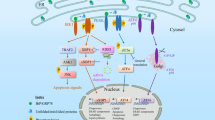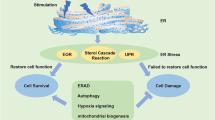Abstract.
In homeostasis, cellular processes are in a dynamic equilibrium. Perturbation of homeostasis causes stress. In this review I summarize how perturbation of three major functions of the endoplasmic reticulum (ER) in eukaryotic cells–protein folding, lipid and sterol biosynthesis, and storing intracellular Ca2+ – causes ER stress and activates signaling pathways collectively termed the unfolded protein response (UPR). I discuss how the UPR reestablishes homeostasis, and summarize our current understanding of how the transition from protective to apoptotic UPR signaling is controlled, and how the UPR induces inflammatory signaling.
Similar content being viewed by others
Author information
Authors and Affiliations
Corresponding author
Additional information
Received 21 August 2007; received after revision 26 October 2007; accepted 29 October 2007
Rights and permissions
About this article
Cite this article
Schröder, M. Endoplasmic reticulum stress responses. Cell. Mol. Life Sci. 65, 862–894 (2008). https://doi.org/10.1007/s00018-007-7383-5
Published:
Issue Date:
DOI: https://doi.org/10.1007/s00018-007-7383-5




